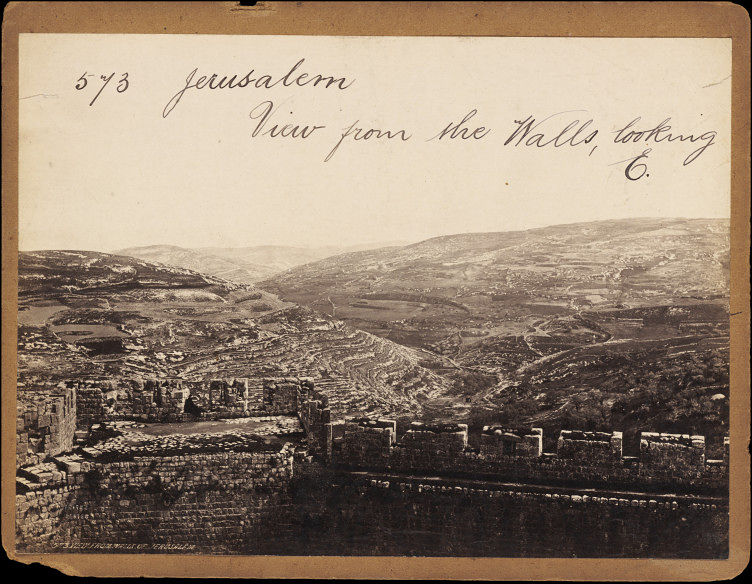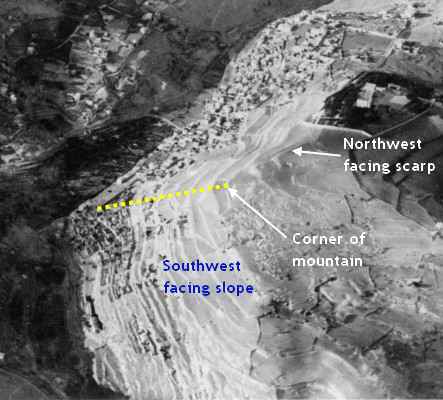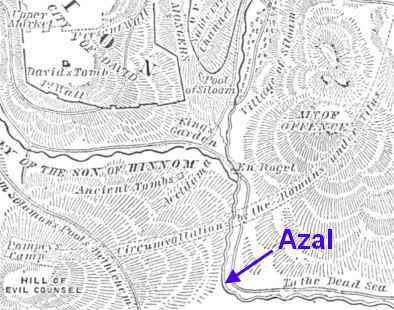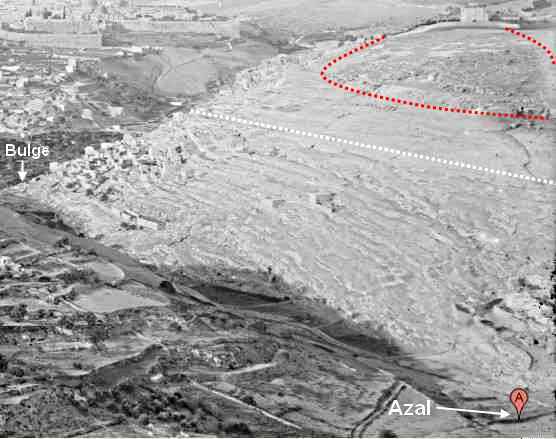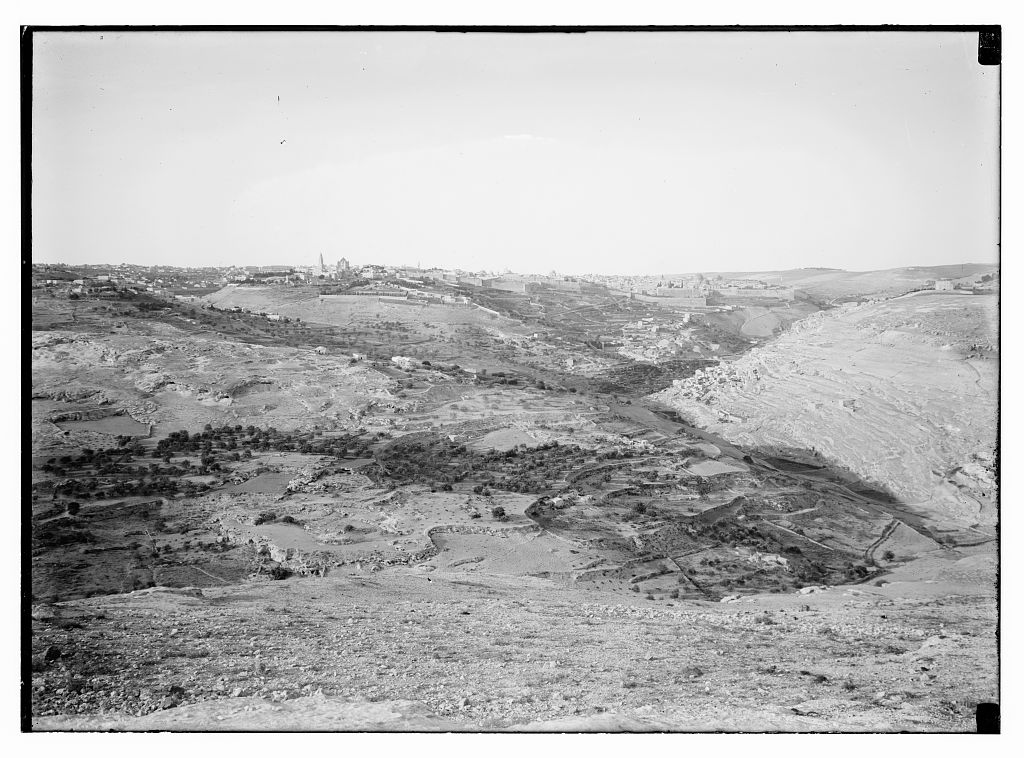Deciphering Zechariah 14:5
Link: https://web.archive.org/web/20180726082950/https://zechariahfourteenfive.wordpress.com/
Azal: A Longtime Mystery Rediscovered
 Deciphering Zechariah 14_5 _ An indepth analysis of Zechariah 14_5.html
In bibles that follow the Greek Septuagint (LXX) rendering, depending upon the source manuscript used, Azal is transcribed Jasol (ιασολ, pronounced Yasol), Jasod (a corruption of Jasol), or Asael (ασαηλ):
The valley of my mountains shall be blocked up; and the valley of mountains shall be closed up even to Jasod [Jasol/Azal]. It shall be blocked up as it was in the days of the earthquake in the days of Ozias [Uzziah] king of Juda. …
Zechariah 14:5, LXX, first English translation by Charles Thomson, Secretary to the first United States Congresss, published 1808
Discovery of Azal
During the period 1873-74, Charles Clermont-Ganneau, a renowned linguist and archaeologist in Palestine, explored a number of ancient tombs in a valley immediately south of Jerusalem that the local Arab peasants called Wadi Yâsûl (wadi is the Arabic word for river or valley). Based on linguistic evidence and its proximity to Jerusalem, Clermont-Ganneau proposed that Wadi Yâsûl is Azal:
“But, as with so many other Arabic topographical words, we may very likely have here an ancient geographical name … most [bible] commentators agree in regarding [Azal] as a place situated not far from Jerusalem, but otherwise unknown. May we not find it at Yâsûl, whose name agrees with it letter for letter?”
Deciphering Zechariah 14_5 _ An indepth analysis of Zechariah 14_5.html
In bibles that follow the Greek Septuagint (LXX) rendering, depending upon the source manuscript used, Azal is transcribed Jasol (ιασολ, pronounced Yasol), Jasod (a corruption of Jasol), or Asael (ασαηλ):
The valley of my mountains shall be blocked up; and the valley of mountains shall be closed up even to Jasod [Jasol/Azal]. It shall be blocked up as it was in the days of the earthquake in the days of Ozias [Uzziah] king of Juda. …
Zechariah 14:5, LXX, first English translation by Charles Thomson, Secretary to the first United States Congresss, published 1808
Discovery of Azal
During the period 1873-74, Charles Clermont-Ganneau, a renowned linguist and archaeologist in Palestine, explored a number of ancient tombs in a valley immediately south of Jerusalem that the local Arab peasants called Wadi Yâsûl (wadi is the Arabic word for river or valley). Based on linguistic evidence and its proximity to Jerusalem, Clermont-Ganneau proposed that Wadi Yâsûl is Azal:
“But, as with so many other Arabic topographical words, we may very likely have here an ancient geographical name … most [bible] commentators agree in regarding [Azal] as a place situated not far from Jerusalem, but otherwise unknown. May we not find it at Yâsûl, whose name agrees with it letter for letter?”

 Landslide
Landslide
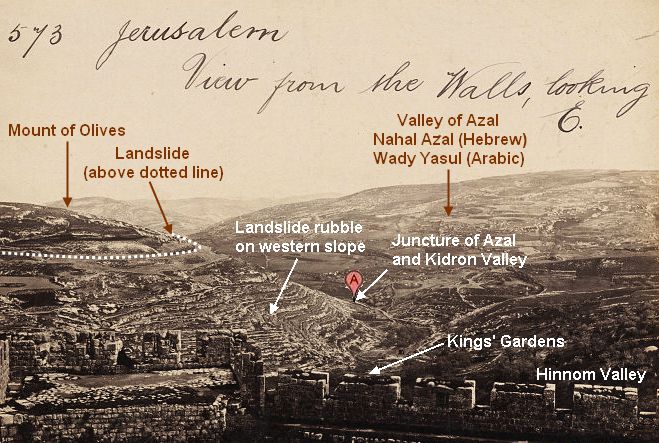
 https://web.archive.org/web/20180726082950/http://collections.vam.ac.uk/item/O215982/photograph-jerusalem-view-from-the-walls/
https://web.archive.org/web/20120726022031/http://collections.vam.ac.uk/item/O215982/jerusalem-view-from-the-walls-photograph-francis-frith/
http://www.loc.gov/pictures/resource/matpc.08432/?co=matpc
http://collections.vam.ac.uk/item/O215982/photograph-jerusalem-view-from-the-walls/
https://web.archive.org/web/20141128111515/http://www.loc.gov/pictures/resource/matpc.08432/?co=matpc
https://tile.loc.gov/storage-services/service/pnp/matpc/08400/08432v.jpg
The
https://web.archive.org/web/20180726082950/http://collections.vam.ac.uk/item/O215982/photograph-jerusalem-view-from-the-walls/
https://web.archive.org/web/20120726022031/http://collections.vam.ac.uk/item/O215982/jerusalem-view-from-the-walls-photograph-francis-frith/
http://www.loc.gov/pictures/resource/matpc.08432/?co=matpc
http://collections.vam.ac.uk/item/O215982/photograph-jerusalem-view-from-the-walls/
https://web.archive.org/web/20141128111515/http://www.loc.gov/pictures/resource/matpc.08432/?co=matpc
https://tile.loc.gov/storage-services/service/pnp/matpc/08400/08432v.jpg
The  Masoretic Text version of Zechariah 14:5 Contradicts Reality
The ‘Splitting’ of the Mount of Olives
The narrative of a split Mount of Olives is based on a particular translation of the Hebrew verb בקע (baqa, H1234; σχιζω, G4977, in LXX) in Zechariah 14:4 that conveys the idea of the Mount of Olives splitting in half. This word is translated similarly in Micah 1:4, which describes landsliding in metaphoric language:
The mountains will melt under him and the valleys will split apart [בקע (baqa, H1234)], like wax in the presence of fire and like water gushing down a steep incline.
Micah 1:4, New International Version
But I think I have found the key to this passage [Zechariah 14:4-5], and will quote for this end the following passage from Josephus, Antiq., book 9., chap. 10., being a part of the history of Uzziah: “… This prodigy was followed by another: near a certain place before the city, named Eroge, the one half of a mountain that looked westward was torn from the other half, and rolled for the space of four furlongs, till it stopped to the eastward of it, by which means the road was blocked up, and the king’s gardens covered with rubbish.
Descriptive Geography and Brief Historical Sketch of Palestine, Joseph Schwarz, pp. 263-264, (1850)
So considering the evidence, it is much more likely that Zechariah 14:4 describes the western half (part) of the Mount of Olives tearing apart from its eastern half (which is exactly what happened), rather than that mountain splitting apart into two halves.
… ונבקע (and is torn) הר (mountain) הזיתים (the olives) מחצין (from his half) טזרחה (eastward) …
Zechariah 14:4, Hebrew interlinear version with reversed word order (right-to-left)
cited from https://web.archive.org/web/20120510135413/http://zechariahfourteenfive.wordpress.com/2010/02/10/hello-world/
Masoretic Text version of Zechariah 14:5 Contradicts Reality
The ‘Splitting’ of the Mount of Olives
The narrative of a split Mount of Olives is based on a particular translation of the Hebrew verb בקע (baqa, H1234; σχιζω, G4977, in LXX) in Zechariah 14:4 that conveys the idea of the Mount of Olives splitting in half. This word is translated similarly in Micah 1:4, which describes landsliding in metaphoric language:
The mountains will melt under him and the valleys will split apart [בקע (baqa, H1234)], like wax in the presence of fire and like water gushing down a steep incline.
Micah 1:4, New International Version
But I think I have found the key to this passage [Zechariah 14:4-5], and will quote for this end the following passage from Josephus, Antiq., book 9., chap. 10., being a part of the history of Uzziah: “… This prodigy was followed by another: near a certain place before the city, named Eroge, the one half of a mountain that looked westward was torn from the other half, and rolled for the space of four furlongs, till it stopped to the eastward of it, by which means the road was blocked up, and the king’s gardens covered with rubbish.
Descriptive Geography and Brief Historical Sketch of Palestine, Joseph Schwarz, pp. 263-264, (1850)
So considering the evidence, it is much more likely that Zechariah 14:4 describes the western half (part) of the Mount of Olives tearing apart from its eastern half (which is exactly what happened), rather than that mountain splitting apart into two halves.
… ונבקע (and is torn) הר (mountain) הזיתים (the olives) מחצין (from his half) טזרחה (eastward) …
Zechariah 14:4, Hebrew interlinear version with reversed word order (right-to-left)
cited from https://web.archive.org/web/20120510135413/http://zechariahfourteenfive.wordpress.com/2010/02/10/hello-world/
 The Truth Hidden Right in Front of Our Eyes Deciphering Zechariah 14_5.html
...the presence of a vast Jewish cemetery covering virtually the entire southern slope, much of the western slope, and part of the eastern slope of the Mount of Olives’ central summit.
...a final gathering on earth is central to Jewish eschatology.
The Truth Hidden Right in Front of Our Eyes Deciphering Zechariah 14_5.html
...the presence of a vast Jewish cemetery covering virtually the entire southern slope, much of the western slope, and part of the eastern slope of the Mount of Olives’ central summit.
...a final gathering on earth is central to Jewish eschatology.
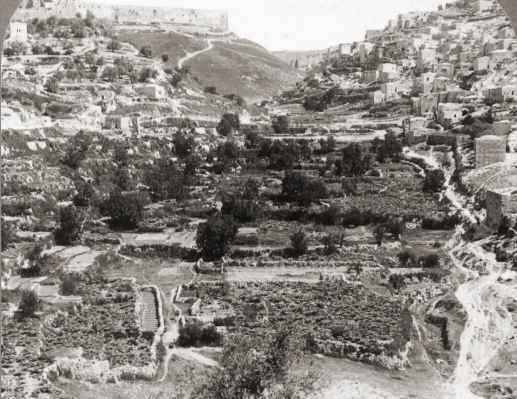
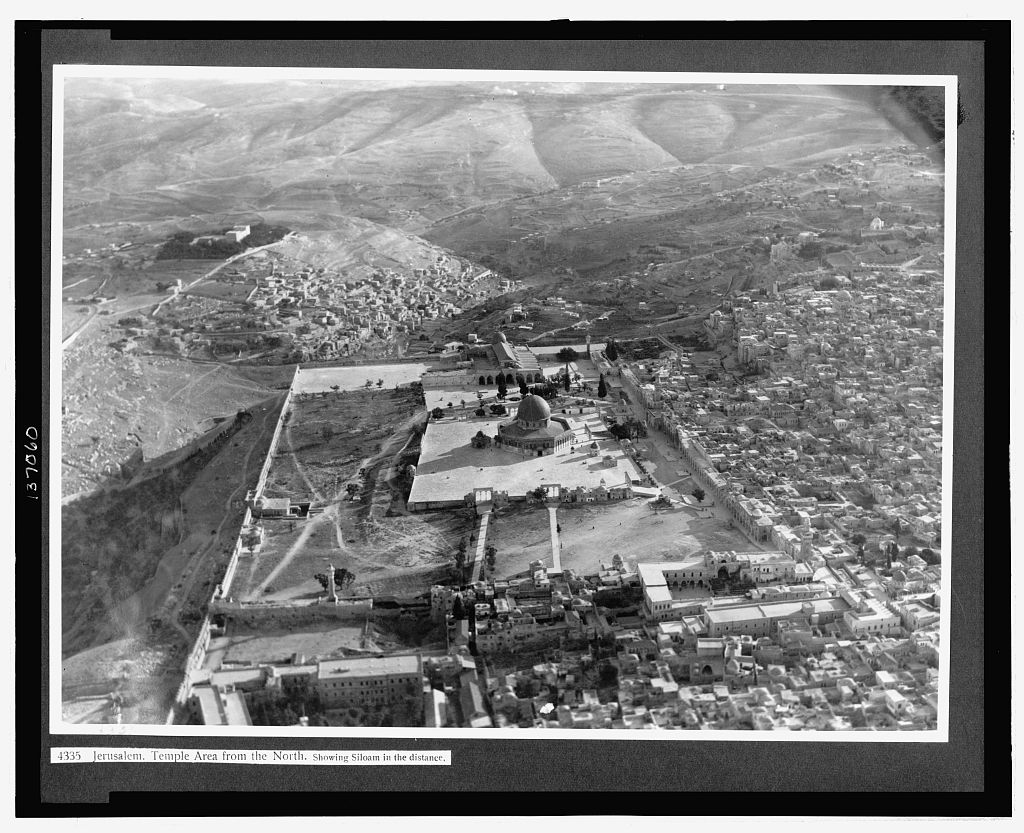
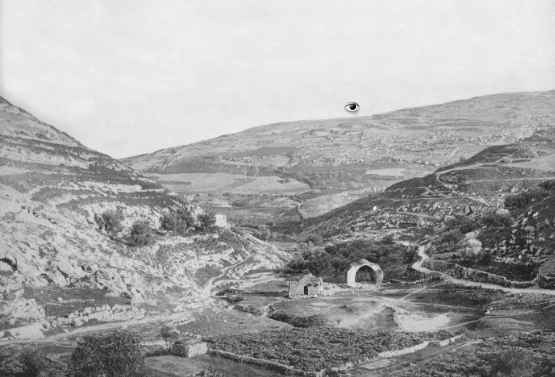 This southerly view shows landslide rubble at the base of the previously mentioned bulge in the Mount of Corruption, where the slope transitions from a southwesterly to a westerly aspect. The very unconsolidated surface material in the leftmost part of the photo is part of the bulge; and the section adjoining it, with the horizontal rows of benches, and the ledge with trees and white square at the very end (which is the end of a building), is the northern end of the southwestern slope.
This southerly view shows landslide rubble at the base of the previously mentioned bulge in the Mount of Corruption, where the slope transitions from a southwesterly to a westerly aspect. The very unconsolidated surface material in the leftmost part of the photo is part of the bulge; and the section adjoining it, with the horizontal rows of benches, and the ledge with trees and white square at the very end (which is the end of a building), is the northern end of the southwestern slope.
 Deciphering Zechariah 14_5 _ An indepth analysis of Zechariah 14_5.html
In bibles that follow the Greek Septuagint (LXX) rendering, depending upon the source manuscript used, Azal is transcribed Jasol (ιασολ, pronounced Yasol), Jasod (a corruption of Jasol), or Asael (ασαηλ):
The valley of my mountains shall be blocked up; and the valley of mountains shall be closed up even to Jasod [Jasol/Azal]. It shall be blocked up as it was in the days of the earthquake in the days of Ozias [Uzziah] king of Juda. …
Zechariah 14:5, LXX, first English translation by Charles Thomson, Secretary to the first United States Congresss, published 1808
Discovery of Azal
During the period 1873-74, Charles Clermont-Ganneau, a renowned linguist and archaeologist in Palestine, explored a number of ancient tombs in a valley immediately south of Jerusalem that the local Arab peasants called Wadi Yâsûl (wadi is the Arabic word for river or valley). Based on linguistic evidence and its proximity to Jerusalem, Clermont-Ganneau proposed that Wadi Yâsûl is Azal:
“But, as with so many other Arabic topographical words, we may very likely have here an ancient geographical name … most [bible] commentators agree in regarding [Azal] as a place situated not far from Jerusalem, but otherwise unknown. May we not find it at Yâsûl, whose name agrees with it letter for letter?”
Deciphering Zechariah 14_5 _ An indepth analysis of Zechariah 14_5.html
In bibles that follow the Greek Septuagint (LXX) rendering, depending upon the source manuscript used, Azal is transcribed Jasol (ιασολ, pronounced Yasol), Jasod (a corruption of Jasol), or Asael (ασαηλ):
The valley of my mountains shall be blocked up; and the valley of mountains shall be closed up even to Jasod [Jasol/Azal]. It shall be blocked up as it was in the days of the earthquake in the days of Ozias [Uzziah] king of Juda. …
Zechariah 14:5, LXX, first English translation by Charles Thomson, Secretary to the first United States Congresss, published 1808
Discovery of Azal
During the period 1873-74, Charles Clermont-Ganneau, a renowned linguist and archaeologist in Palestine, explored a number of ancient tombs in a valley immediately south of Jerusalem that the local Arab peasants called Wadi Yâsûl (wadi is the Arabic word for river or valley). Based on linguistic evidence and its proximity to Jerusalem, Clermont-Ganneau proposed that Wadi Yâsûl is Azal:
“But, as with so many other Arabic topographical words, we may very likely have here an ancient geographical name … most [bible] commentators agree in regarding [Azal] as a place situated not far from Jerusalem, but otherwise unknown. May we not find it at Yâsûl, whose name agrees with it letter for letter?”

 Landslide
Landslide

 https://web.archive.org/web/20180726082950/http://collections.vam.ac.uk/item/O215982/photograph-jerusalem-view-from-the-walls/
https://web.archive.org/web/20120726022031/http://collections.vam.ac.uk/item/O215982/jerusalem-view-from-the-walls-photograph-francis-frith/
http://www.loc.gov/pictures/resource/matpc.08432/?co=matpc
http://collections.vam.ac.uk/item/O215982/photograph-jerusalem-view-from-the-walls/
https://web.archive.org/web/20141128111515/http://www.loc.gov/pictures/resource/matpc.08432/?co=matpc
https://tile.loc.gov/storage-services/service/pnp/matpc/08400/08432v.jpg
The
https://web.archive.org/web/20180726082950/http://collections.vam.ac.uk/item/O215982/photograph-jerusalem-view-from-the-walls/
https://web.archive.org/web/20120726022031/http://collections.vam.ac.uk/item/O215982/jerusalem-view-from-the-walls-photograph-francis-frith/
http://www.loc.gov/pictures/resource/matpc.08432/?co=matpc
http://collections.vam.ac.uk/item/O215982/photograph-jerusalem-view-from-the-walls/
https://web.archive.org/web/20141128111515/http://www.loc.gov/pictures/resource/matpc.08432/?co=matpc
https://tile.loc.gov/storage-services/service/pnp/matpc/08400/08432v.jpg
The  Masoretic Text version of Zechariah 14:5 Contradicts Reality
The ‘Splitting’ of the Mount of Olives
The narrative of a split Mount of Olives is based on a particular translation of the Hebrew verb בקע (baqa, H1234; σχιζω, G4977, in LXX) in Zechariah 14:4 that conveys the idea of the Mount of Olives splitting in half. This word is translated similarly in Micah 1:4, which describes landsliding in metaphoric language:
The mountains will melt under him and the valleys will split apart [בקע (baqa, H1234)], like wax in the presence of fire and like water gushing down a steep incline.
Micah 1:4, New International Version
But I think I have found the key to this passage [Zechariah 14:4-5], and will quote for this end the following passage from Josephus, Antiq., book 9., chap. 10., being a part of the history of Uzziah: “… This prodigy was followed by another: near a certain place before the city, named Eroge, the one half of a mountain that looked westward was torn from the other half, and rolled for the space of four furlongs, till it stopped to the eastward of it, by which means the road was blocked up, and the king’s gardens covered with rubbish.
Descriptive Geography and Brief Historical Sketch of Palestine, Joseph Schwarz, pp. 263-264, (1850)
So considering the evidence, it is much more likely that Zechariah 14:4 describes the western half (part) of the Mount of Olives tearing apart from its eastern half (which is exactly what happened), rather than that mountain splitting apart into two halves.
… ונבקע (and is torn) הר (mountain) הזיתים (the olives) מחצין (from his half) טזרחה (eastward) …
Zechariah 14:4, Hebrew interlinear version with reversed word order (right-to-left)
cited from https://web.archive.org/web/20120510135413/http://zechariahfourteenfive.wordpress.com/2010/02/10/hello-world/
Masoretic Text version of Zechariah 14:5 Contradicts Reality
The ‘Splitting’ of the Mount of Olives
The narrative of a split Mount of Olives is based on a particular translation of the Hebrew verb בקע (baqa, H1234; σχιζω, G4977, in LXX) in Zechariah 14:4 that conveys the idea of the Mount of Olives splitting in half. This word is translated similarly in Micah 1:4, which describes landsliding in metaphoric language:
The mountains will melt under him and the valleys will split apart [בקע (baqa, H1234)], like wax in the presence of fire and like water gushing down a steep incline.
Micah 1:4, New International Version
But I think I have found the key to this passage [Zechariah 14:4-5], and will quote for this end the following passage from Josephus, Antiq., book 9., chap. 10., being a part of the history of Uzziah: “… This prodigy was followed by another: near a certain place before the city, named Eroge, the one half of a mountain that looked westward was torn from the other half, and rolled for the space of four furlongs, till it stopped to the eastward of it, by which means the road was blocked up, and the king’s gardens covered with rubbish.
Descriptive Geography and Brief Historical Sketch of Palestine, Joseph Schwarz, pp. 263-264, (1850)
So considering the evidence, it is much more likely that Zechariah 14:4 describes the western half (part) of the Mount of Olives tearing apart from its eastern half (which is exactly what happened), rather than that mountain splitting apart into two halves.
… ונבקע (and is torn) הר (mountain) הזיתים (the olives) מחצין (from his half) טזרחה (eastward) …
Zechariah 14:4, Hebrew interlinear version with reversed word order (right-to-left)
cited from https://web.archive.org/web/20120510135413/http://zechariahfourteenfive.wordpress.com/2010/02/10/hello-world/
 The Truth Hidden Right in Front of Our Eyes Deciphering Zechariah 14_5.html
...the presence of a vast Jewish cemetery covering virtually the entire southern slope, much of the western slope, and part of the eastern slope of the Mount of Olives’ central summit.
...a final gathering on earth is central to Jewish eschatology.
The Truth Hidden Right in Front of Our Eyes Deciphering Zechariah 14_5.html
...the presence of a vast Jewish cemetery covering virtually the entire southern slope, much of the western slope, and part of the eastern slope of the Mount of Olives’ central summit.
...a final gathering on earth is central to Jewish eschatology.


 This southerly view shows landslide rubble at the base of the previously mentioned bulge in the Mount of Corruption, where the slope transitions from a southwesterly to a westerly aspect. The very unconsolidated surface material in the leftmost part of the photo is part of the bulge; and the section adjoining it, with the horizontal rows of benches, and the ledge with trees and white square at the very end (which is the end of a building), is the northern end of the southwestern slope.
This southerly view shows landslide rubble at the base of the previously mentioned bulge in the Mount of Corruption, where the slope transitions from a southwesterly to a westerly aspect. The very unconsolidated surface material in the leftmost part of the photo is part of the bulge; and the section adjoining it, with the horizontal rows of benches, and the ledge with trees and white square at the very end (which is the end of a building), is the northern end of the southwestern slope.
